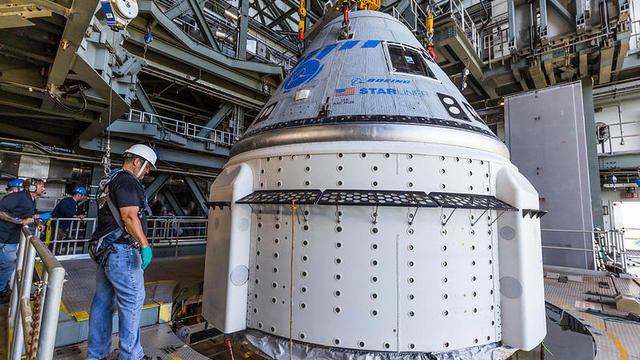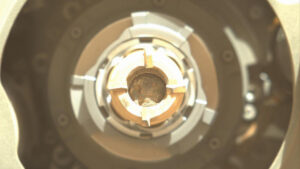Boeing gives up on near-term launch of Starliner space capsule

Boeing gives up on near-term launch of Starliner space capsule
Around-the-clock work to fix valve problems that derailed an August 3 attempt to launch Boeing’s Starliner crew capsule on an unpiloted test flight was called off Friday, delaying another try until after NASA launches a higher-priority asteroid probe in mid October.
Despite the team’s eagerness to fly, “we have to have the maturity to stop, investigate and sit before flying again,” said Kathy Lueders, NASA’s chief of space operations. “And that is what we are doing. We fly when we are ready.”
“I know this is very, very hard on our NASA-Boeing team, but I’m very proud of them for how diligently and carefully they’ve been working. … We’re going to go fix this problem. And we’re going to move forward.”
The delay marked the latest setback for the hard-luck Starliner, which suffered major software problems during the commercial crew ship’s initial test flight in December 2019, preventing an attempt to rendezvous with the International Space Station and nearly leading to a catastrophic failure.
After months of troubleshooting and analysis, Boeing ordered a second unpiloted test flight to demonstrate a variety of corrective actions and to prove the spacecraft was finally ready to begin carrying astronauts to and from the lab complex, possibly by the end of the year.
But it never got that far.
The day before the Starliner’s planned launch atop its United Launch Alliance Atlas 5 rocket, engineers discovered several propulsion system valves in the service module directly below the crew capsule were not in the correct positions.
After troubleshooting failed to resolve the problem, the countdown was called off and the launch put on hold. The Atlas 5 was rolled off pad 41 at the Cape Canaveral Space Force Station and back to ULA’s Vertical Integration Facility for more invasive analysis.
The Starliner’s service module features 28 reaction control system thrusters providing 85 pounds of thrust each. Twenty more powerful orbital maneuvering and attitude control thrusters provide 1,500 pounds of push and four big launch abort engines, each with 40,000 pounds of thrust, are available for emergency use.
The thrusters are powered by an extremely toxic fuel known as monomethylhydrazine along with an “oxidizer” known as nitrogen tetroxide. The propellants ignite on contact, simplifying thruster design, and they are widely used across the space industry.
The Starliner propellants are routed to the maneuvering thrusters through 48 valves, 24 for fuel and 24 for oxidizer. Pressurized helium, used to push the propellants through the complex plumbing, is routed through another 16 valves.
“These valves are important, they isolate the thrusters from the propellant tanks, and they needed to be open for flight in order to have the appropriate thrusters for aborts and on-orbit maneuvering for the vehicle,” said Steve Stich, NASA’s commercial crew program manager.
The Starliner problem involved 13 oxidizer valves that were initially found to be stuck in the closed position. Engineers eventually got nine of them to open but four did not respond despite repeated efforts this week.
John Vollmer, manager of Boeing’s commercial crew program program, said the valves worked normally during the 2019 test flight and they all operated normally during pre-flight tests this time around, before the capsule was moved to the launch pad.
Vollmer said engineers suspect water vapor in the air somehow made its way into cavities in the balky oxidizer valves where it reacted with nitrogen tetroxide to create an acid. The acid then led to corrosion that caused the valves to stick.
Vollmer said it’s normal for a small amount of nitrogen tetroxide to seep across, or permeate, Teflon seals in the valves, but the cavities are harmlessly vented to vacuum in space. The seepage wasn’t the problem, but water vapor, possibly associated with torrential afternoon thunderstorms the day before the planned August 3 launch, may well have been the culprit.
“The most probable cause of what we’re looking at is that we’re seeing some permeation of the oxidizer through some of the seals in the valve itself,” Vollmer said. “There was some moisture on the dry side of the valve, and that interaction, we believe, created some nitric acid. That nitric acid resulted in some corrosion which resulted in the stiction of those valves.”
Boeing may have been able to correct the remaining valve problems at the pad if more time was available, but the schedule was too tight.
ULA must use a different Atlas 5 to launch NASA’s higher-priority “Lucy” asteroid probe on October 16, the opening of a 22-day planetary launch window. If Lucy misses its window, the flight will be delayed a full year while Earth and the probe’s asteroid targets move back into favorable positions.
Complicating the schedule, SpaceX plans to launch a Dragon cargo ship to the space station on August 28 that will dock at the same port needed by the Starliner.
To allow time for “stacking” and tests of Lucy’s Atlas 5, and because the Cargo Dragon will be docked at the Starliner’s port throughout September, the Boeing capsule had to be off the ground by around August 20 at the latest.
On Friday, still faced with four stuck valves, Boeing threw in the towel and ordered the Starliner back to the factory.



